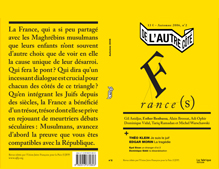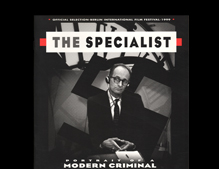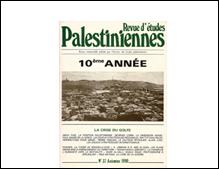-
Proposal for a visual media exhibition
with the participation of students of the Master of Film at the Dutch Film Academy, Amsterdam -
Get my films
Buy DVDs online at www.momento-films.com -
IZKOR
slaves of memory
Documentary film | 1990 | 97 min | color | 16mm | 4:3 | OV Hebrew ST -
Common Archive Palestine 1948
web based cross-reference archive and production platform
www.commonarchives.net/1948 - Project in progress - -
Montage Interdit [forbidden editing]
With professors Ella (Habiba) Shohat and Robert Stam / Berlin Documentary Forum 2 / Haus der Kulturen der Welt / June 2012 -
Route 181
fragments of a journay in Palestine-Israel
Documentary film co-directed with Michel Khleifi | 2003 | 272 min [4.5H] | color | video | 16:9 | OV Arabic, Hebrew ST
-
The Specialist
portrait of a modern criminal
Documentary film | 1999 | co-author Rony Brauman | 128 min | B/W | 4:3 | 35 mm | OV German, Hebrew ST -
Jaffa
the orange's clockwork
Documentary film | 2009 | 88 min | color & B/W | 16:9 | Digital video | OV Arabic, Hebrew, English, French ST
-
Montage Interdit
www.montageinterdit.net
Web-based documentary practice. A production tool, archive and distribution device | project in progress
-
Common State
potential conversation [1]
Documentary film | 2012 | 123 min | color | video | 16:9 split screen | OV Arabic, Hebrew ST -
Towards a common archive
testimonies by Zionist veterans of 1948 war in Palestine
Visual Media exhibition | Zochrot Gallery (Zochrot visual media lab) | Tel-Aviv | October 2012 - January 2013
-
I Love You All
Aus Liebe Zum Volk
Documentary film co-directed with Audrey Maurion | 2004 | 89 minutes | b/w & color | 35mm | OV German, French ST
reviews
Fragments of a Journey in Palestine-Israel by Maureen Clare Murphy (The Electronic Intifada)
13.06.2004
Capturing the fragments of a land shattered by politics, history, and colonialism, Route 181: Fragments of a Journey in Israel-Palestine, clocks in at about four and a half hours. The film's length is epic-worthy, but it allows the filmmakers to present oral history from a wide variety of people who live along the 1947 partition line, while at the same time allow for minutes-long footage of the monotonous grey concrete wall that quietly runs along one of the region's main roads. By portraying both the divide of the physical landscape and that of the humans that inhabit it, viewers receive a fuller understanding of this conflicted part of the world.
Like the text at the beginning of the film indicates, Route 181, a collaborative effort between Israeli filmmaker Eyal Sivan and his Palestinian peer Michel Khleifi, is truly a cinematic journey. Viewers meet Israelis and Palestinians of a wide variety of backgrounds and politics. Disillusioned Israeli Jews of Moroccan descent wish they had never emigrated to Israel in the first place, while adolescent Palestinian citizens of Israel, because they are educated with an Israeli curriculum, squabble over whether they are Palestinian or Israeli. This is what the film does best, and why it is four and a half hours long -- it introduces to its audience, through extended interviews with various Israelis and Palestinians, the nuanced complexity of those people who live along the green line.
One of the common criticisms of the one-state solution to the Israeli-Palestinian conflict is that it could never happen because the two parties hate each other. What this film shows is that there is indeed deep racial hatred, but amongst Israelis towards Palestinians, not the other way around. An Israeli construction manager says, "We always say that a good Arab is a dead Arab," completely unashamed of his naked racism. What complicates this is that the man espousing such hatred is a Moroccan Jew.
A young Palestinian man living with his mother in the Negev says that people in Israel say death to the Arabs, but if a Palestinian were to write death to the Jews on the street just once, there would be an outrage. He adds, the real relationship of conflict is one of "occupiers and the occupied," rather than "Jews versus Arabs." And as the camera shoots the view from the filmmakers' car, the audience is shown signs that say "the Palestinian state is in Jordan" and "crush Palestinians to end the war."
One Jewish Israeli woman, who works at a cafe postered with images of Israeli military aircraft, tells the filmmakers that her shop used to belong to an Arab, and that she regrets that the Arab homes weren't destroyed when the area was colonized. Annoyed with the old Arabs who wander around in the homes, she says that she would like to see the land rid "of that cancer," referring to the indigenous Palestinian population. She adds that there will be no peace "as long as we're here," a disturbing but not isolated attitude present in Israel that suicide is preferable to being neighbors with the Palestinians.
None of the Palestinians featured in the film share the racism of many of the Israelis interviewed. Palestinian after Palestinian recalls a time when Jews, Christians, and Muslims lived together harmoniously, religion being a non-issue. One Palestinian woman peasant says of the earlier Jewish immigrants, "They came here and we welcomed them," but recognizes how Palestinians were and continue to be pushed off of their land.
Many of the Israelis in the film fail to acknowledge the root of the conflict to be the colonization of the land and the expulsion of its indigenous population. A former Haganah officer repeatedly retorts "who invaded whom?" when one of the filmmakers challenges him on his military exploits. By focusing on how Arab states invaded the newly established state of Israel in 1948, the old man misses the point -- it was because the land was being occupied and cleansed by a foreign presence that the violence was instigated.
Other Israelis deflect all responsibility to the Palestinians by insisting that because Arabs rejected the U.N. partition plan in 1947, Israelis should feel no guilt for demolishing Arab towns and denying the Palestinians their right to return home. Another elderly Jewish Israeli tells how he helped kill Arabs and ran women and children off the land in 1948. He said the actions were part of "Operation Matate," matate meaning broom. The operation was given the name "because we swept out the Arabs."
When the man refuses to accept responsibility for the war, saying that his actions were just because the Zionists accepted the partition and the Arabs didn't, the filmmaker asks him if he knows the Biblical story of Solomon, who recognized the true mother of a disputed baby to be the one who refused to split the child in two. The Israeli man, not initially recognizing that he's falling into the filmmaker's trap, then insists that the Arabs were killed "for our own survival."
Of course, not all of the Jewish Israelis portrayed are as ignorant as those just described. An aging Polish Jew, who seems disillusioned with what the state of Israel has turned into, remembers how the old settlements didn't displace the Arabs. "We came as neighbors," he says. And an Iraqi Jew storeowner says he would have happily lived with Arabs, and vice versa. "Some people in this country ... possibly don't want peace," he observes.
But it is telling just how total detachment from history pervades the Israelis in the film. One man gives an upbeat talk about how his historic home is adorned with Arabic script on the walls, but then insists "there were no Arabs here," asking, "what do you hope to do by filming ruins?"
The film also potrays gulfs between different segments of the Israeli population. In a particularly memorable scene at an integration center, unsmiling Ethiopian Jews sit on folding chairs, unimpressed by the white Jews playing cheerful songs on a recorder and accordion. The Israeli woman presiding over the integration ceremony brashly asks the crowd if they know any Hebrew, without any response, and then instructs them in Hebrew to hurry up and dip their apples in honey and to drink some wine, as if she were talking to a group of grade schoolers.
Route 181 does assume knowledge of the history of the Israeli-Palestinian conflict, so it might be difficult for newcomers to the conflict to access the film. But those familiar with the Palestinian narrative will find all three of the film's 84-minute segments totally compelling, because the filmmakers don't bother explaining and rationalizing the Palestinians' grievances (although Palestinian voices are still an important part of the film). Instead, they cut right to the chase, interrogating the Israelis on their attitudes that are often incompatible with peaceful resolution. The filmmaker's sympathies towards the Palestinians are clear, and it can be easily inferred that they favor the one-state solution.
It is not without significance that the filmmaker's titled their route after the United Nations resolution that divided the land, splitting it in two. And by using the Solomon metaphor more than once, it is safe to assume that Sivan and Khleifi think it would be better for Israelis and Palestinians to live together rather than apart. But the filmmakers realize that those Jewish Israelis who place a purely Jewish state over coexistence with the Palestinians are an obstacle to their preferred solution, and the film is determined to bring those attitudes to the forefront.
Maureen Clare Murphy, a recent graduate from the School of the Art Institute of Chicago, is Arts, Music, and Culture Editor for EI.
Like the text at the beginning of the film indicates, Route 181, a collaborative effort between Israeli filmmaker Eyal Sivan and his Palestinian peer Michel Khleifi, is truly a cinematic journey. Viewers meet Israelis and Palestinians of a wide variety of backgrounds and politics. Disillusioned Israeli Jews of Moroccan descent wish they had never emigrated to Israel in the first place, while adolescent Palestinian citizens of Israel, because they are educated with an Israeli curriculum, squabble over whether they are Palestinian or Israeli. This is what the film does best, and why it is four and a half hours long -- it introduces to its audience, through extended interviews with various Israelis and Palestinians, the nuanced complexity of those people who live along the green line.
One of the common criticisms of the one-state solution to the Israeli-Palestinian conflict is that it could never happen because the two parties hate each other. What this film shows is that there is indeed deep racial hatred, but amongst Israelis towards Palestinians, not the other way around. An Israeli construction manager says, "We always say that a good Arab is a dead Arab," completely unashamed of his naked racism. What complicates this is that the man espousing such hatred is a Moroccan Jew.
A young Palestinian man living with his mother in the Negev says that people in Israel say death to the Arabs, but if a Palestinian were to write death to the Jews on the street just once, there would be an outrage. He adds, the real relationship of conflict is one of "occupiers and the occupied," rather than "Jews versus Arabs." And as the camera shoots the view from the filmmakers' car, the audience is shown signs that say "the Palestinian state is in Jordan" and "crush Palestinians to end the war."
One Jewish Israeli woman, who works at a cafe postered with images of Israeli military aircraft, tells the filmmakers that her shop used to belong to an Arab, and that she regrets that the Arab homes weren't destroyed when the area was colonized. Annoyed with the old Arabs who wander around in the homes, she says that she would like to see the land rid "of that cancer," referring to the indigenous Palestinian population. She adds that there will be no peace "as long as we're here," a disturbing but not isolated attitude present in Israel that suicide is preferable to being neighbors with the Palestinians.
None of the Palestinians featured in the film share the racism of many of the Israelis interviewed. Palestinian after Palestinian recalls a time when Jews, Christians, and Muslims lived together harmoniously, religion being a non-issue. One Palestinian woman peasant says of the earlier Jewish immigrants, "They came here and we welcomed them," but recognizes how Palestinians were and continue to be pushed off of their land.
Many of the Israelis in the film fail to acknowledge the root of the conflict to be the colonization of the land and the expulsion of its indigenous population. A former Haganah officer repeatedly retorts "who invaded whom?" when one of the filmmakers challenges him on his military exploits. By focusing on how Arab states invaded the newly established state of Israel in 1948, the old man misses the point -- it was because the land was being occupied and cleansed by a foreign presence that the violence was instigated.
Other Israelis deflect all responsibility to the Palestinians by insisting that because Arabs rejected the U.N. partition plan in 1947, Israelis should feel no guilt for demolishing Arab towns and denying the Palestinians their right to return home. Another elderly Jewish Israeli tells how he helped kill Arabs and ran women and children off the land in 1948. He said the actions were part of "Operation Matate," matate meaning broom. The operation was given the name "because we swept out the Arabs."
When the man refuses to accept responsibility for the war, saying that his actions were just because the Zionists accepted the partition and the Arabs didn't, the filmmaker asks him if he knows the Biblical story of Solomon, who recognized the true mother of a disputed baby to be the one who refused to split the child in two. The Israeli man, not initially recognizing that he's falling into the filmmaker's trap, then insists that the Arabs were killed "for our own survival."
Of course, not all of the Jewish Israelis portrayed are as ignorant as those just described. An aging Polish Jew, who seems disillusioned with what the state of Israel has turned into, remembers how the old settlements didn't displace the Arabs. "We came as neighbors," he says. And an Iraqi Jew storeowner says he would have happily lived with Arabs, and vice versa. "Some people in this country ... possibly don't want peace," he observes.
But it is telling just how total detachment from history pervades the Israelis in the film. One man gives an upbeat talk about how his historic home is adorned with Arabic script on the walls, but then insists "there were no Arabs here," asking, "what do you hope to do by filming ruins?"
The film also potrays gulfs between different segments of the Israeli population. In a particularly memorable scene at an integration center, unsmiling Ethiopian Jews sit on folding chairs, unimpressed by the white Jews playing cheerful songs on a recorder and accordion. The Israeli woman presiding over the integration ceremony brashly asks the crowd if they know any Hebrew, without any response, and then instructs them in Hebrew to hurry up and dip their apples in honey and to drink some wine, as if she were talking to a group of grade schoolers.
Route 181 does assume knowledge of the history of the Israeli-Palestinian conflict, so it might be difficult for newcomers to the conflict to access the film. But those familiar with the Palestinian narrative will find all three of the film's 84-minute segments totally compelling, because the filmmakers don't bother explaining and rationalizing the Palestinians' grievances (although Palestinian voices are still an important part of the film). Instead, they cut right to the chase, interrogating the Israelis on their attitudes that are often incompatible with peaceful resolution. The filmmaker's sympathies towards the Palestinians are clear, and it can be easily inferred that they favor the one-state solution.
It is not without significance that the filmmaker's titled their route after the United Nations resolution that divided the land, splitting it in two. And by using the Solomon metaphor more than once, it is safe to assume that Sivan and Khleifi think it would be better for Israelis and Palestinians to live together rather than apart. But the filmmakers realize that those Jewish Israelis who place a purely Jewish state over coexistence with the Palestinians are an obstacle to their preferred solution, and the film is determined to bring those attitudes to the forefront.
Maureen Clare Murphy, a recent graduate from the School of the Art Institute of Chicago, is Arts, Music, and Culture Editor for EI.




























































